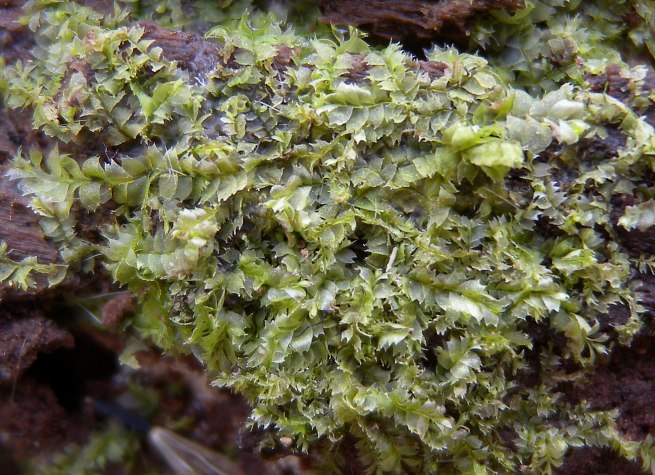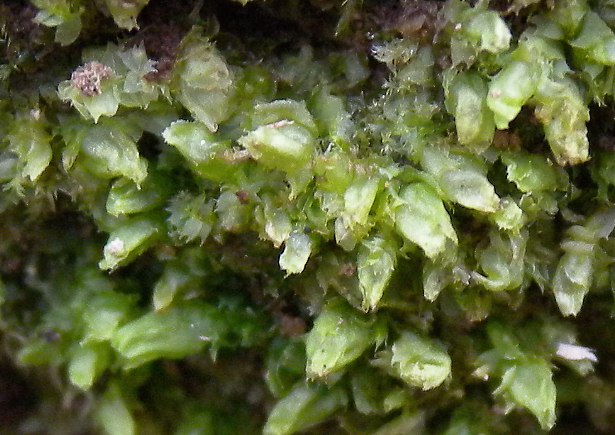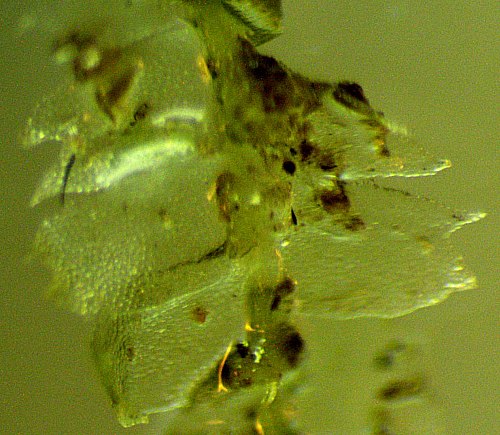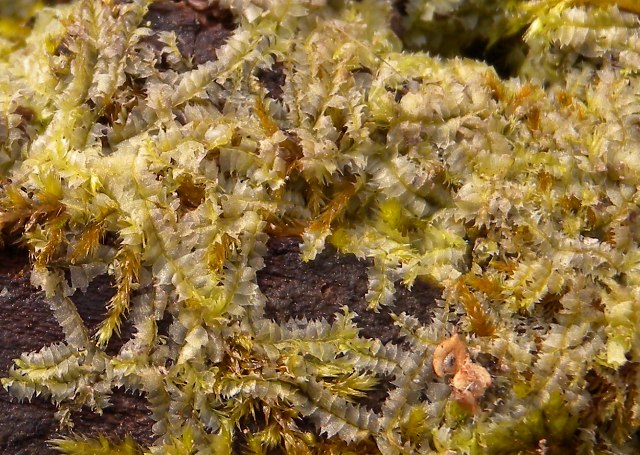
On sterile shoots and toward the bases of fertile shoots, the tips of lateral leaves usually have a pair of narrow triangular lobes that are separated by U-shaped sinuses. These lobes extend to about one-fourth of the length of their leaves. The bases of lateral leaves clasp the stems. Both the lower and upper surfaces of the leaves are light green to light golden green; they are translucent and only one cell deep. Along the lower side of each stem where the lateral leaves are opposite from each other, there are smaller underleaves. These underleaves are up to 0.5 mm. in length, rectangular in shape, and deeply divided into 2 narrow lobes. Individual cells of leaves are about 25-30 micrometers across and they have an irregular hexagonal in shape. The cellular walls and their trigones (where the cell walls intersect) are narrow. Each leaf cell has 4-8 oil bodies that are granular in shape and dark green.

Occasionally, some main shoots and lateral shoots terminate in solitary perianths containing the female sex organs (androecia). The perianth is 2-4 mm. long, ovoid-triangular in shape, more or less erect, and light green with whitish tips. The perianth is formed from 3 modified leafy bracts that have been joined together partially; the perianth is usually crested at its apex with short fine teeth. Along the leafy stems, 1-3 pairs of modified leafy bracts occur occasionally that contain the male sex organs (antheridia); these latter bracts are deeply concave or pouch-like and they are usually located near the perianths. After fertilization from released sperm, the perianths develop small spore-bearing capsules on slender stalks. This occurs during the spring for a period of 1-2 weeks. Spore-bearing capsules are either dark brown or black and globoid in shape, while their stalks are translucent white and terete. At maturity, each capsule divides into 4 equal parts to release its tiny spores to the wind. Shortly afterwards, both the divided capsule and its stalk wither away. At the base of the underleaves along its shoots, this liverwort develops fine rhizoids that cling to the substrate.
Cultivation: This liverwort prefers shade during the summer, although it can tolerate some sunlight during the cooler parts of the year. It requires an area with high humidity that is protected from the wind. The best substrate consists of rotting decorticated logs or rotting decorticated branches (somewhat soft logs and branches without their bark) that are located on the ground, preferably near a body of shallow water (small stream or shallow pool) above the upper waterline.

Range & Habitat: Variable-leaved Crestwort (Lophocolea heterophylla) is native to Illinois, where it is occasional in most areas of the state (see Distribution Map). Because of its small size and the difficulties in identifying leafy liverworts, it is probably more common than herbarium records indicate. This leafy liverwort is widely distributed in North America and Europe. In Illinois, habitats include rotting barkless logs and rotting barkless tree branches on moist ground in deciduous woods, rotting tree stumps in moist woods, moist ground at the bases of trees in woods, exposed roots of trees along creeks, sandstone walls and sandstone ledges in wooded rocky canyons, shaded clay banks along creeks, low ground along streams in woods, shaded earthen banks near lake spillways, and patches of shaded moist soil along rocky slopes. Overall, Variable-leaved Crestwort is found in higher quality natural areas, although it tolerates disturbance to a greater extent than many other leafy liverworts.
Faunal Associations: At the present time, no information is available for this species about floral-faunal relationships.
Photographic Location: A rotting decorticated log near a shallow pool of water at Busey Woods in Urbana, Illinois. The close-up photograph was taken indoors.

Comments: This is the most common crestwort (Lophocolea sp.) in Illinois. Variable-leaved Crestwort (Lophocolea heterophylla) is very similar in appearance to Bifid Crestwort (Lophocolea bidentata) and Cuspidate Crestwort (Lophocolea cuspidata), except the leaves of the latter two species are always bilobed and they tend to be slightly larger in size. Because Bifid Crestwort is dioecious (producing male reproductive organs and female reproductive organs on separate plants), it rarely produces fertile perianths from which spore-bearing capsules originate. In contrast, Cuspidate Crestwort is monoecious (producing male reproductive organs and female reproductive organs on the same plant), like Variable-leaved Crestwort, and it often produces fertile perianths. While the perianths of Variable-leaved Crestwort have short fine teeth along their upper margins, the perianths of Bifid Crestwort and Cuspidate Crestwort are either coarsely dentate or they have long narrow teeth along their upper margins. It is possible that the few reports of Bifid Crestwort and Cuspidate Crestwort in Illinois may be misidentifications of the sterile shoots of Variable-leaved Crestwort. Another uncommon species is Lesser Crestwort (Lophocolea minor). This latter species differs from the preceding species by its smaller size (with leafy shoots about 0.5–1.5 mm. across) and the abundance of gemmae (clonal buds) that are found along the margins of its leaves. A scientific synonym of Variable-leaved Crestwort is Chiloscyphus profundus.